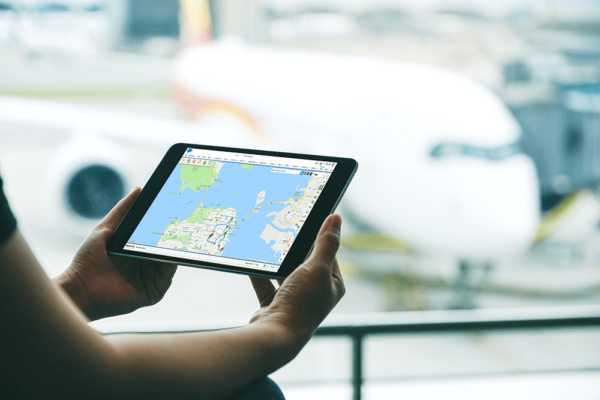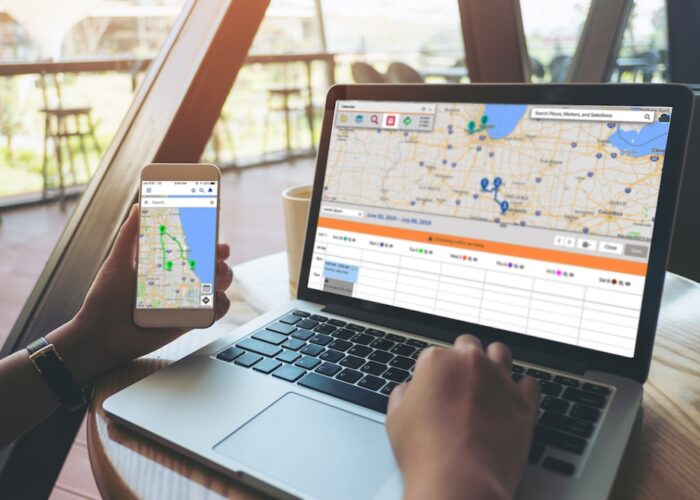
Our October 2019 release is on it’s way and will be available for sandbox installs Saturday, September 28th! Every 3 – 4 months Geopointe releases new and improved features and functionalities for admins and end-users alike. Read on to see some of the great new features that will be available within Geopointe. All updates and new functionalities below will available on the AppExchange beginning September 28th.
Geopointe’s Mobile Experience
Knowing that many of our customers have mobile sales teams, we understand the need to have a great experience with Geopointe while using Salesforce mobile.
First, let’s focus on our new tablet experience. With our new user interface (UI), features like routing, calendar, layers, legend, user preferences, and searching will appear on a panel along the right hand side of the page. With this update, users will always have visibility of the map while working in Geopointe on a tablet.
For a look at how the tablet new experience, click here for a short video.
Improved Mobile Legend
This legend is, wait for it… Legendary! We have brought the popular interactive legend feature from our desktop experience to our mobile solution as well. Tablet users will now find the legend opens in the side panel. Touching on the legend values will toggle off/on visibility of that grouping from the map.
On smaller devices, like a phone, the legend will still be available, but will pop up from the bottom of the screen rather than a side panel.
Calendar Start/End Locations Plus Working Hours
With our October 2019 release, every Geopointe user can now not only set up their default working hours but also their start and end location, impacting the calendar user experience on both mobile and desktop. To set them up, find the Working Hours section within your user settings and press the button to edit the working hours.
While users can edit the start location, end location or each day’s working hours as default values that will be used in Calendar, they can also be overridden within the calendar.
1-Touch Calendar Scheduling
Your calendar scheduling is about to get a whole lot easier with Geopointe’s ability to schedule events with the touch of a button.
Geopointe’s 1-Touch Scheduling will help users place planned items into the proper timing within a day on their calendar. For example, a user may start with a day clear of appointments, with only the user’s start and end locations present. The user can then add events to the calendar’s staging area and, with 1-Touch Scheduling, drag those items into the appropriate time slots or let the system do the heavy lifting for them. The 1-Touch Scheduling feature comes in the form of the ‘Add All’ button at the top of the staging area.
Once ‘Add All’ is pressed, the system will analyze the current day’s schedule and look to place as many of the items from the staging area into the schedule as possible, taking their location into account as well as the location of any existing appointments. The end result is the staging items are placed into the calendar at recommended times.
The map will then automatically update with the planned schedule. Users can also touch on any appointment to modify its timing or even drag it to to new time.
For more on Geopointe’s Calendar-Based Scheduling from our June 2019 Release, click here.
Search Along a Line (Route, Calendar, Drawn Line)
We are very excited to share that Geopointe users are now able to search along a line (most commonly a route, calendar travel or manually drawn lines using the line tool when using Geopointe) on the map.
For example, if a Geopointe user has a route displayed on the map and wanted to start a search they can either click the search icon on the route toolbar or click the route line to see the option to search. The search takes place directly on the map and the Route layer is updated on the Layer Manager, allowing the user to see that range along the route and how the aggregate values roll up from the data set.
Nearby Time Searches Traffic Considerations
We know that, in some cities, traffic is a major consideration when planning out your day. Therefore, our October 2019 release now provides the ability to specify a day and time values (average traffic conditions during that day and time) when performing a nearby search of the following types:
- Minutes (Driving)
- Hours (Driving)
- Miles (Driving)
- Kilometers (Driving)
Route Sharing Model
While Geopointe routes have historically been owned by one user and shareable in a read-only fashion, they are now more efficient for a collaborative environment with route sharing.
With the October 2019 release, an administrator will now be able to move a Geopointe installation from the old model to a new model that leverages the Salesforce sharing rules for all visibility and permissions to the route record. With the new model, a user can easily share their route to specific people giving any/all of them read-write access.
All new Geopointe installs will automatically use the new sharing model. However, our existing customers need to migrate their solutions to the new model. It’s very easy to do, but we wanted to make it an explicit choice the admin needs to make.
NOTE: Once you migrate to the new route sharing model, you are unable to return to the old model. The use of the Route Sharing model is how Geopointe is now intended to operate moving forward.
We hope you are as excited for the October 2019 Release as we are and you get the chance to try out some of Geopointe’s new features. For a full list and detailed description of our October 2019 release features and improvements, please refer to our October 2019 release notes available on the Geopointe Help Site.
Want to learn more about Geopointe’s October 2019 release? Sign up now for our webinar covering all of the new specs, features and use cases available to you!



